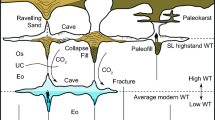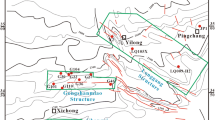Abstract
The chemical composition of mixed-layer serpentine/chlorite (Sp/Ch) in Tuscaloosa Formation sandstone was analyzed by energy dispersive X-ray spectroscopy (EDX) in the scanning electron miscroscope (SEM) and by X-ray diffraction (XRD). EDX results indicate little depth-controlled variation in composition, whereas XRD results suggest distinct decreases in octahedral Fe and tetrahedral Al. XRD-determined compositions appear to be erroneous and actually reflect progressive changes in Sp/Ch unit-cell dimensions caused by polytype transformations of Ibb layers to Iaa layers in a mixed-layer Ibb/Iaa polytype. The relative lack of variation in Sp/Ch composition, especially when compared to other studies of chlorite minerals over similar temperature ranges, is attributed to a reaction mechanism whereby mineralogic transformations (serpentine layers to chlorite layers and Ibb layers to Iaa layers) occur on a layer-by-layer basis within coherent crystallites, rather than by dissolution-precipitation crystal growth.
The lack of titanium in chlorite minerals is attributed to high levels of octahedral Al3+ that prohibit inclusion of the highly charged Ti4+ in the octahedral sheet. Anatase (TiO2) in the Tuscaloosa Formation apparently formed when Ti was liberated during crystallization of Sp/Ch following the breakdown of a Ti-bearing precursor (detrital ultramafic clasts and/or odinite). Odinite, an Fe-rich 7-Å phyllosilicate that forms in some shallow marine sands, apparently existed as a short-lived, poorly crystallized intermediary between dissolution of the ultramafic clasts and formation of Sp/Ch.
Similar content being viewed by others
References
Abrecht J, Hewitt DA. 1988. Experimental evidence on the substitution of Ti in biotite. Am Mineral 73:73–1284.
Ahn JH, Peacor DR. 1985. Transmission electron microscopic study of diagenetic chlorite in Gulf Coast argillaceous sediments. Clays Clay Miner 33:33–237.
Al-Dahan AA, Morad S. 1986. Chemistry of detrital biotites and their phyllosilicate intergrowths in sandstones. Clays Clay Miner 34:34–548.
Alford EV. 1983. Compositional variations of authigenic chlorites in the Tuscaloosa Formation, Upper Cretaceous of the Gulf Coast Basin [M.S. thesis]. New Orleans, LA: Univ. of New Orleans.
Annerston H. 1968. A mineral chemical study of a metamorphosed iron formation in northern Sweden. Lithos 1:1–397.
Bachinski SW, Simpson EL. 1984. Ti-phlogopites of the Shaw’s Cove Minette: A comparison with micas of other lamprophyres, potassic rocks, kimberlites and mantle xenoliths. Am Mineral 69:41–56.
Bailey SW. 1972. Determination of chlorite compositions by X-ray spacings and intensities. Clays Clay Miner 20:20–388.
Bailey SW., 1988a. Odinite, a new dioctahedral-trioctahedral Fe3+-rich 1:1 clay mineral. Clay Miner 23:23–247.
Bailey SW., 1988b. Chlorites: Structures and crystal chemistry. In: Bailey SW, editor. Hydrous phyllosilicates (exclusive of micas), Rev Mineral 19. Washington, DC: Mineral Soc Am. p 347–403.
Bailey SW, Banfield JF, Barker WW. 1995. Dozyite, a 1:1 regular interstratifiaction of serpentine and chlorite. Am Mineral 80:65–77.
Brigatti MF, Poppi L, Fabbri A. 1991. Corrensites: genetic relationships assessed by multivariate statistical analysis. Bull Mineral 109:109–553.
Brindley GW. 1961. Chlorite minerals. In: Brown G, editor. The X-ray identification and crystal structures of clay minerals. London: Mineral Soc. p 242–296.
Brindley GW. 1982. Chemical composition of berthierines—A review. Clays Clay Miner 30:30–155.
Brown G, Bailey SW. 1962. Chlorite polytypism: I. Regular and semi-random one-layer structures. Am Mineral 47:47–850.
Cathelineau M. 1988. Cation site occupancy in chlorites and illites as a function of temperature. Clay Miner 23:23–485.
Cathelineau M, Nieva D. 1985. A chlorite solid solution geothermometer: The Los Azufres (Mexico) geothermal system. Contrib Mineral Petrol 91:91–244.
Chagnon A, Desjardins M. 1991. Determination de la composition de la chlorite par diffraction et microanalyse aux rayons X. Can Mineral 29:245–254.
Curtis CD, Ireland BJ, Whiteman JA, Mulvaney R, Whittle CK. 1984. Authigenic chlorites: Problems with chemical analysis and structural formula calculation. Clay Miner 19:19–481.
de Caritat P, Hutcheon I, Walshe JL. 1993. Chlorite geothermometry: A review. Clays Clay Miner 41:41–239.
Deer WA, Howie RA, Zussman J. 1992. An introduction to the rock-forming minerals, 2nd ed. New York: J Wiley. 696 p.
Eberl DD, Srodon J, Kralik M, Taylor BE, Peterman ZE. 1990. Ostwald ripening of clays and metamorphic minerals. Science 248:248–477.
Eggleton RA, Banfield JF. 1985. The alteration of granitic biotite to chlorite. Am Mineral 70:70–910.
Ehrenberg SN. 1993. Preservation of anomolously high porosity in deeply buried sandstones by grain-coating chlorite examples from the Norwegian Continental Shelf. Am Assoc Petrol Geol Bull 77:77–1286.
von Engelhardt W. 1942. Die Structuren von Thuringit, Bavalit, und Chamosit und ihre Stellung in der Chloritgruppe. Z Kristallogr 104:142–159.
Forbes WC, Flower MFJ. 1974. Phase relations of titan-phlogopite, K2Mg4TiAl2Si6O20(OH)4: A refractory phase in the upper mantle? Earth Planet Sci Lett 22:60–66.
Foster MD. 1962. Interpretation of the composition and a classification of the chlorites. US Geol Survey Prof Paper 414-A:1–33.
Guidotti CV. 1984. Micas in metamorphic rocks. In: Bailey SW, editor. Micas, Rev Mineral 13. Washington, DC: Mineral Soc Am., p 357–467.
Guidotti CV, Cheney JT, Guggenheim S. 1977. Distribution of titanium between coexisting muscovite and biotite in pelitic schists from Northwestern Maine. Am Mineral 62:62–448.
Hamlin KH, Cameron CP. 1987. Sandstone petrology and diagenesis of Lower Tuscaloosa Formation reservoirs in the McComb and Little Creek field areas, southwest Mississippi. Trans Gulf Coast Assoc Geol Soc 37:95–104.
Heald MT, Anderegg RC. 1960. Differential cementation in the Tuscarora sandstone. J Sed Petrol 30:30–577.
Hearne JH, Lock BE., 1985. Diagenesis of the Lower Tuscaloosa as seen in the DuPont de Nemours #1 Lester Earnest, Harrison County, Mississippi. Trans Gulf Coast Assoc Geol Soc 35:35–393.
Hillier S. 1994. Pore-lining chlorites in siliciclastic reservoir sandstones: Electron microscope, SEM, and XRD data, and implications for their origin. Clay Miner 29:665–679.
Hillier S, Velde B. 1991. Octahedral occupancy and chemical composition of diagenetic (low-temperature) chlorites. Clay Miner 26:26–168.
Hogg MD. 1988. Newtonia Field: A model for mid-dip Lower Tuscaloosa retrograde deltaic sedimentation. Trans Gulf Coast Assoc Geol Soc 38:38–471.
Hornibrook ERC, Longstaffe FJ. 1996. Berthierine from the Lower Cretaceous Clearwater Formation, Alberta, Canada. Clays Clay Miner 44:1–21.
Hunter BE, Davies DK. 1979. Distribution of volcanic sediments in the Gulf Coast Province—Significance to petroleum geology. Trans Gulf Coast Assoc Geol Soc 29:29–155.
Iijima A, Matsumoto R. 1982. Berthierine and chamosite in coal measures of Japan. Clays Clay Miner 30:30–274.
Jahren JS. 1991. Evidence of Ostwald ripening related recrystallization of diagenetic chlorites from reservoir rocks offshore Norway. Clay Miner 26:26–178.
Jahren JS, Aagaard P. 1989. Compositional variations in diagenetic chlorites and illites, and their relationships with formation water chemistry. Clay Miner 24:157–170.
Jahren JS, Aagaard P. 1992. Diagenetic illite-chlorite assemblages in arenites: I. Chemical evolution. Clays Clay Miner 40:40–546.
James HL. 1966. Chemistry of the iron-rich sedimentary rocks. US Geol Survey Prof Paper 440-W. 60 p.
Jiang W-T, Peacor DR, Buseck PR. 1994. Chlorite geothermometry?—Contamination and apparent octahedral vacancies. Clays Clay Miner 42:42–605.
Jiang W-T, Peacor DR, Slack JF. 1992. Microstructures, mixed-layering, and polymorphism of chlorite and retrograde berthierine in the Kidd Creek massive sulfide deposit, Ontario. Clays Clay Miner 40:501–514.
Kepezhinskas KB. 1965. Composition of chlorites as determined from their physical properties. Dokl Akad Nauk S.S.S.R, Earth Sci Sect 164:126–129 (English).
Labotka TC. 1983. Analysis of the compositional variation of biotite in pelitic hornfelses from Northeastern Minnesota. Am Mineral 68:68–914.
Laird J. 1988. Chlorites: Metamorphic petrology. In: Bailey SW, editor. Hydrous phyllosilicates (exclusive of micas), Rev Mineral 19. Washington, DC: Mineral Soc Am. p 405–447.
Li G, Peacor DR. 1993. Sulfides precipitated in chlorite altered from detrital biotite: A mechanism for local sulfate reduction? Abstr Progr Geol Soc Am Annu Meet 25:146–147.
McDowell SM, Elders WA. 1980. Authigenic layer silicate minerals in borehole Elmore #1, Salton Sea Geothermal Field California. Contrib Mineral Petrol 74:293–310.
Monier G, Robert JL. 1986. Titanium in muscovites from two mica granites: Substitutional mechanism and partition with coexisting biotites. Neues Jarbuch fuer Mineralogie, Abhandlungen 153:147–161.
Morad S. 1986. SEM Study of authigenic rutile, anatase, and brookite in Proterozoic sandstones from Sweden. Sed Geol 46:77–89.
Nelson BW, Roy R. 1958. Synthesis of the chlorites and their structural and chemical constitution. Am Mineral 43:43–725.
Newman ACD. 1987. Chemistry of clays and clay minerals. New York: J Wiley. 480 p.
Odin GS. 1990. Clay mineral formation at the continent-ocean boundary: The verdine facies. Clay Miner 25:25–483.
Otten MT, Buseck PR. 1987. TEM study of the transformation of augite to sodic pyroxene in eclogitized ferrogabbro. Contrib Mineral Petrol 96:96–538.
Patino Douce AE. 1993. Titanium substitution in biotite: An empirical model with applications to thermometry, O2 and H2O barometries, and consequences for biotite stability. Chem Geol 108:133–162.
Pittman ED, Lumsden DN. 1968. Relationship between chlorite coatings on quartz grains and porosity, Spiro Sand, Oklahoma. J Sed Petrol 38:668–670.
Reynolds RC Jr. 1985. NEWMOD—A computer program for the calculation of one-dimensional diffraction profiles of clays. Hanover, New Hampshire: RC Reynolds, Jr, 8 Brook Road.
Reynolds RC Jr, DiStefano MP, Lahann RW. 1992. Randomly interstratified serpentine/chlorite: Its detection and quantification by powder X-ray diffraction methods. Clays Clay Miner 40:40–267.
Ryan PC. 1994. Serpentine/chlorite and illite/smectite in the Tuscaloosa Formation: Origins, chemistry, mineralogic structures, and oxygen isotope compositions [Ph.D. thesis]. Hanover, NH: Dartmouth College. 177 p.
Ryan PC, Reynolds RC Jr. 1996. The origin and diagenesis of grain-coating serpentine-chlorite in Tuscaloosa Formation sandstone, U.S. Gulf Coast. Am Miner 81:213–225.
Schulze DG. 1982. The identification of soil iron oxide minerals by differential X-ray diffraction. Soil Sci Soc Am J 45:45–440.
Shirozu H. 1958. X-ray powder and cell dimensions of some chlorites in Japan, with a note on their interference colors. Mineral J (Jpn) 2:209–223.
Shirozu H. 1980. Cation distribution, sheet thickness, and O-OH space in trioctahedral chlorites—An X-ray and infrared study. Mineral J (Jpn) 10:14–34.
Stancliffe RJ, Adams ER. 1986. Lower Tuscaloosa fluvial channel styles at Liberty Field, Amite County, Mississippi. Trans Gulf Coast Assoc Geol Soc 36:305–313.
Thomsen A. 1982. Preservation of porosity in the Deep Woodbine/Tuscaloosa Trend, Louisiana. J Petrol Technol 34:1156–1162.
Velde B. 1989. Phyllosilicate formation in berthierine peloids and iron oolites. In: Young TP, Taylor WEG, editors. Phanerozoic ironstones. London: Geol Soc Spec Publ 46. p 3–8.
Velde B, Raoult J-F, Leikine M. 1974. Metamorphosed berthierine pellets in mid-Cretaceous rocks from north-eastern Algeria. J Sed Petrol 44:44–1280.
Walker JR, Hluchy MM, Reynolds RC Jr. 1988. Estimation of heavy atom content and distribution in chlorite using corrected X-ray powder diffraction intensities. Clays Clay Miner 36:359–364.
Walker JR, Thompson GR. 1990. Structural variations in illite and chlorite in a diagenetic sequence from the Imperial Valley, California. Clays Clay Miner 38:315–321.
Whitney PR, McClelland JM. 1983. Origin of biotite-horn-blende-garnet coronas between oxides and plagioclase in olivine metagabbros, Adirondack Region, New York. Contrib Mineral Petrol 82:34–41.
Whittle CK. 1986. Comparison of sedimentary chlorite compositions by X-ray diffraction and analytical TEM. Clay Miner 21:937–947.
Wiygul GJ, Young LM. 1987. A subsurface study of the Lower Tuscaloosa Formation at Olive Field, Pike and Amity Counties, Mississippi. Trans Gulf Coast Assoc Geol Soc 37:295–302.
Yau YC, Peacor DR, Essene EJ. 1987. Authigenic anatase and titanite in shales from the Salton Sea geothermal field, California. Neues Jarbuch fuer Mineralogie, Monatshefte 10:441–452.
Yoneyama H, Haga S, Yamanaka S. 1989. Photocatalytic activities of microcrystalline TiO2 incorporated in sheet silicates of clay. J Phys Chem 93:93–4837.
Xu H, Veblen DR. 1993. Periodic and disordered interstratification and other microstructures in the chlorite-berthierine series [abstract]. Abstr Progr Geol Soc Am Annu Meet 25:146.
Author information
Authors and Affiliations
Rights and permissions
About this article
Cite this article
Ryan, P.C., Reynolds, R.C. The Chemical Composition of Serpentine/Chlorite in the Tuscaloosa Formation, United States Gulf Coast: EDX vs. XRD Determinations, Implications for Mineralogic Reactions and the Origin of Anatase. Clays Clay Miner. 45, 339–352 (1997). https://doi.org/10.1346/CCMN.1997.0450305
Received:
Accepted:
Published:
Issue Date:
DOI: https://doi.org/10.1346/CCMN.1997.0450305




